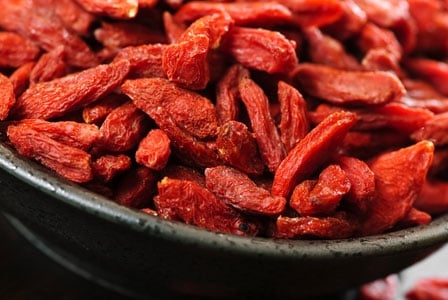
This Superfood Spotlight we take a look at the goji berry, a tart, brightly coloured fruit garnering much attention for its health benefits.
This Superfood Spotlight we take a closer look at the goji berry (Lycium barbarum and Lycium chinense). Also referred to as the wolfberry, this tart, brightly coloured fruit has garnered much attention from the natural health community in recent years—and for good reason.
Traditional use and origin
For thousands of years the goji berry has been used in traditional Chinese medicine. Its earliest mention in Chinese literature dates back to the first century AD.
Goji berries were believed to offer anti-inflammatory effects as well as liver support, and some touted them for their longevity-promoting abilities. One legend describes an herbalist who took goji berries in combination with other herbal tonics and lived until the ripe age of 252—not bad, eh?
Although they grow in many places, goji berries are cultivated primarily in China.
Modern medicinal use
Goji berries are taken today for a variety of ailments including diabetes, high blood pressure, fever, malaria, cancer, poor blood circulation, impotence, dizziness, and tinnitus; however, there’s not sufficient evidence to support the efficacy of goji berries for all of these concerns.
That said, goji berries have extraordinarily high levels of antioxidants, in particular zeaxanthin, which is linked to eye health and protects the eyes against sun damage. One 2011 study showed that healthy elderly participants who supplemented with goji berries daily for three months experienced reduced age-related drusen formation. (Drusens are small yellowish lesions in the eye that cause macular degeneration.)
In another study adult mice were fed a milk-based preparation containing goji berries. Results suggested their immune system response to be enhanced with supplementation, as shown by an increase in T cells and reduced influenza symptoms.
As well, goji berries contain high levels of vitamin A (140 percent of our daily recommended intake is in a single 28 g serving), which is necessary for good eye health, reproduction, immunity, cellular communication, and normal function of the lungs, heart, kidneys, and other organs.
Buying goji berries
Goji berries are typically available in their dried form in natural health food stores. Further, select retailers may sell goji berry juice and freeze-dried goji berry powder. You may also notice many natural food products containing goji berries, such as cereals, granola bars, and teas; however, beware the sugar content of some of these products—they might not be as healthy as you think.
Eating goji berries
Throw dried goji berries into smoothies, sprinkle them atop a bowl of steaming oatmeal, or simply pop them in your mouth for a tangy snack.
Alternatively, incorporate them into a tasty meal, such as this antioxidant-rich salad from Matthew Kadey, RD.
Chickpea Goji Berry Salad
2/3 cup (160 mL) slivered almonds
1 – 19 oz (532 g) can chickpeas, drained and rinsed
1 – 10 oz (280 g) can mandarin orange segments, drained
2/3 cup (160 mL) dried goji berries
1 small red onion, diced
1 clove garlic, minced
1 in (2.5 cm) piece fresh ginger, minced
1 small jalapeno pepper, seeded and minced
1 cup (250 mL) parsley, chopped
4 oz (125 mL) feta cheese, cubed
2 Tbsp (30 mL) apple cider vinegar
2 Tbsp (30 mL) extra-virgin olive oil
Fresh ground black pepper to taste
In dry skillet over medium heat, toast slivered almonds until golden brown, about 4 minutes, stirring often.
Combine all ingredients in large bowl. Store in refrigerator for several hours before serving.
Serves 4.
Each serving contains: 467 calories; 16 g protein; 23 g total fat (6 g sat. fat, 0 g trans fat); 53 g carbohydrates; 11 g fibre; 561 mg sodium







